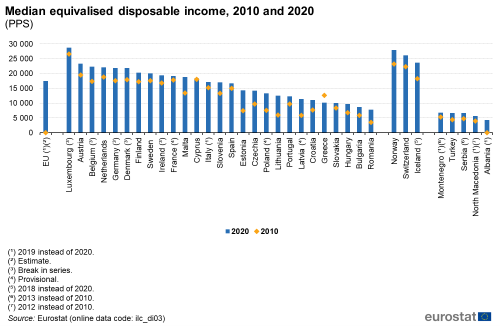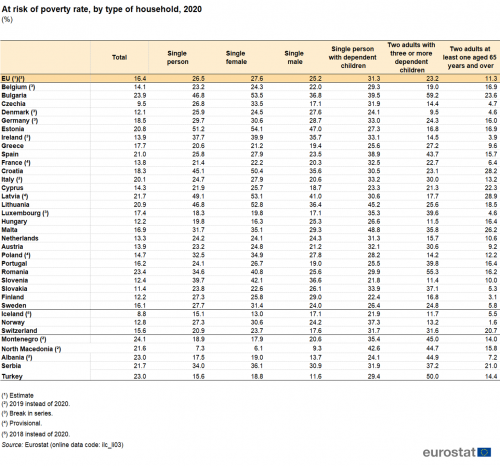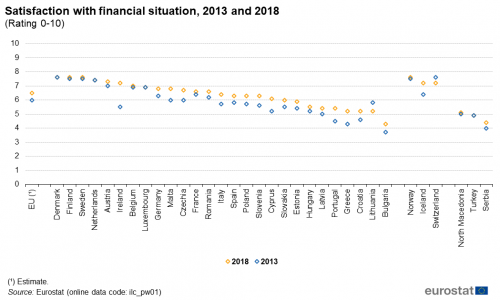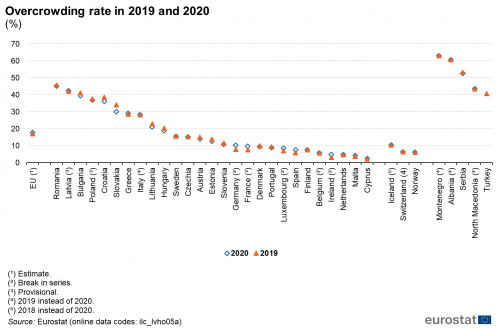Quality of life indicators - material living conditions
Data extracted in January 2022.
Planned update: 11 November 2024.
Highlights
In 2020, 17.8 % of the EU population were living in overcrowded dwellings, 0.7 pp more than in 2019.
Median equivalised disposable income, 2010 and 2020
This article is part of a Eurostat online publication that focuses on Quality of life indicators, providing recent statistics for the European Union (EU). The publication presents a detailed analysis of various dimensions that can form the basis for a more profound analysis of the quality of life, complementing gross domestic product (GDP) which has traditionally been used to provide a general overview of economic and social developments.
The focus of this article is the first dimension — material living conditions — of the nine dimensions which form a framework endorsed by an expert group on quality of life indicators. Even for those dimensions which extend beyond the material cost of living, an individual’s quality of life is often constrained by economic (monetary) factors, as material resources can often be transformed into well-being in line with each individual’s preferences and capabilities. That said, material living standards should not be viewed exclusively in quantitative monetary terms, as consumption patterns, material deprivation and housing conditions may also play a considerable role in determining an individual’s subjective well-being (life satisfaction, happiness, having a meaning to life).
Full article
General overview
The European policy aims to reduce poverty and social exclusion. Nevertheless, there are still wide discrepancies and inequalities in terms of material living standards, both between EU Member States, as well as within them (for example, between different population subcategories, such as an analysis by age or by household type shows). In 2020, more than 1 in 4 Romanians faced severe material or social deprivation, while about 2 % of all citizens in Luxembourg had the same problem. Another example concerning discrepancies within the country: 33.1 % of single parents with dependent children in Ireland were at risk of poverty, compared with about 13.9 % of the total population.
In general, the risk of poverty and social exclusion is much higher in southern and eastern Europe than it is in most of the western and Nordic Member States and also some central ones, while income inequality is generally much less prevalent in the Nordic and the Benelux countries than it is in most of southern and eastern Europe and the Baltic Member States. However, some exceptions to these general patterns also exist: for example, the lowest risk of poverty was found in Czechia, while inequality in Luxembourg — the richest EU Member State in terms of disposable income — was at a moderate level and increasing significantly in the last 10 years.
Regarding housing conditions, while it was common for many people in eastern Europe to be living in overcrowded housing (with the exception of Czechia, Estonia and Slovenia), it was also true that a relatively high proportion of disadvantaged groups in some parts of western Europe were living in low-quality housing (for example, more than one fourth of single parents in Belgium lived in a dwelling with structural problems).
Income
In 2019 (there are no aggregated figures for 2020), median equivalised disposable income in the EU was 17 422 purchasing power standard (PPS). This indicator varied widely across the EU Member States, from 7 724 PPS in Romania to 28 675 PPS in Luxembourg (in 2020). As shown in Map 1, there was a relatively clear geographical divide: median levels of equivalised disposable income were over 16 000 PPS in the Nordic and the western Member States.By contrast, median equivalised disposable income was below 16 000 PPS in all of the Member States which joined the EU after 2004 except for Cyprus, Malta and Slovenia, as well as in two southern Member States — Greece and Portugal.
Iceland, Norway and Switzerland all recorded median levels of equivalised disposable income considerably higher than the EU average, while incomes were much lower (approximately one third of the EU average) in the candidate countries Turkey, Serbia, Montenegro, Albania and North Macedonia.
A comparison of median equivalised disposable income levels between 2010 and 2020 is presented in Figure 1. In the vast majority of the EU Member States, the median level of income rose during the period under consideration. However, there was a substantial decrease in Greece where the median income fell by almost one fifth (by 2 429 PPS).
The highest increases in median equivalised disposable income (in relative terms) were recorded in Romania (+ 118 %) and Lithuania (109%), the only countries which could more than double their scores from 2010.
Income distribution and inequality
How do we measure income inequality?
While median disposable income is a useful indicator for analysing the purchasing power of an average citizen (and therefore indicative of their overall material living standards), it is the distribution of income and wealth that determines by which extent individuals have equal access to the goods and services produced within a national economy.
Alongside the allocation of resources (in other words, the distribution of income between different groups), individuals may also have subjective perceptions of inequality as an evaluation of ‘social fairness’. This relative concept (individuals compare their own situation with that of their peers) is also important in a quality of life framework.
The income quintile share ratio, often referred to as the ‘S80/S20 ratio’, is a basic measure of income distribution. It is calculated as the ratio of total income received by the 20 % of the population with the highest income (the top quintile) to that received by the 20 % of the population with the lowest income (the bottom quintile). For example, an S80/S20 ratio of six means that people at the top of the income scale earn on average six times more than those situated at the bottom of the income scale. While it does not convey information on the distribution of income across all economic groups, this indicator provides a convenient means of comparing income inequalities over time and/or across countries.
Income inequality in the EU
In 2020, the income quintile share ratio in the EU was 5.2 (see Map 2). Czechia, Finland, Slovakia, Slovenia and Belgium were the most egalitarian EU Member States (on the basis of this measure), each with a ratio below 4. Income inequalities were much higher (over 6) in Lithuania, Latvia, Germany, Romania and - peaking at 8.0 - in Bulgaria.
To note a general pattern, the EU Member States that recorded the highest levels of median equivalised disposable income tended to have relatively low levels of income inequality. There were, however, some exceptions to these patterns. For example, Luxembourg — the EU Member State with the highest disposable income per inhabitant — registered a medium level of inequality, while it was at a low level in Czechia, a country with modest levels of disposable income compared with some of the other Member States.
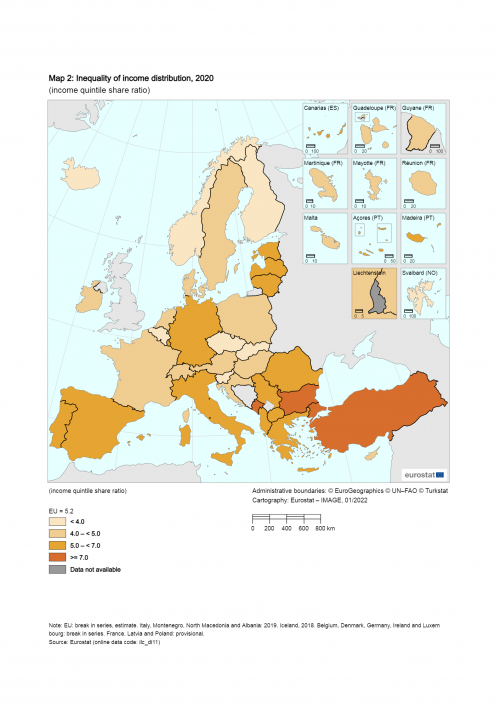
(income quintile share ratio)
Source: Eurostat (ilc_di11)
Evolution of income inequality in the EU over time
An analysis of the period 2010 to 2020 reveals that income inequalities decreased during these years in fifteen of the 27 EU Member States. The largest falls were recorded in Lithuania (S80/S20 ratio decreased from 7.4 to 6.1) and Croatia (5.5 versus 4.6) as well as Poland (5.0 versus 4.1).
By contrast, there was a widening of income inequalities in many Member States and this was the most apparent in Bulgaria (from 5.9 to 8.0) and Germany (from 4.5 to 6.5), (see Figure 2).

(income quintile share ratio)
Source: Eurostat (ilc_di11)
Income inequality by age group
Income inequalities are lower among the elderly than among people aged less than 65: in the EU in 2020, the income share ratio was 5.4 for people aged less than 65 and 4.5 for people aged 65 years and over (see Figure 3). This pattern of less inequality among the elderly was observed in nearly all EU Member States, with the only three exceptions being Hungary (where the reverse could be observed), Portugal and Croatia (for which the difference between the ratios for the two age groups was negligible). The discrepancy between income quintile share ratios for these two age groups was largest in Bulgaria, Romania and Greece.
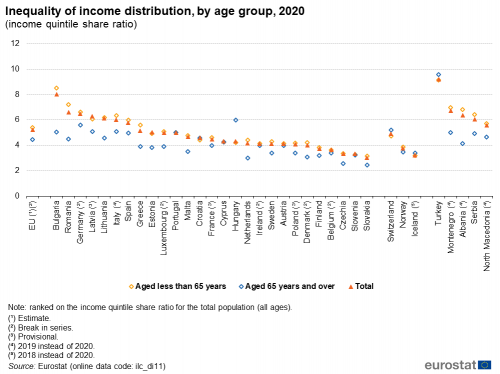
(income quintile share ratio)
Source: Eurostat (ilc_di11)
Risk of poverty
A relative measure of poverty
While poverty is an intuitively familiar concept, its statistical measurement raises methodological difficulties, especially when examined as a dimension in relation to the quality of life. Poverty may be simply defined as the practical difficulty to satisfy basic needs and achieve a decent living standard. However, as inferred above, poverty has both a multi-dimensional nature and is a relative concept, as individuals strive to achieve a minimum standard of living through the interplay between income distribution, consumption patterns and wealth. The issue of poverty measurement is a complex one, not only because of the difficulties in defining it unambiguously. Ideally, all three dimensions (income, consumption and wealth) should be measured using the same data source, in order to identify vulnerable populations better. Moreover, in a statistical sense, poverty can be measured either in absolute terms (against a predefined set of basic needs) or in relative terms (against an average level that varies from one economy to another). Both objective and subjective measures should ideally be used: for example, the share of the population at risk of poverty is a relative and objective indicator, the severe material and social deprivation rate is an absolute and objective measure, whereas the ability to face unexpected financial expenses is a subjective measure.
Within the EU, policymakers have tended to adopt a relative approach based on income (after social transfers) so as to reflect the notion that poverty is related to social exclusion. By doing so, the risk of poverty can be measured in economic terms as persistent conditions under which a person cannot afford to participate fully in the society in which they live. According to this approach, a person’s risk of poverty is conventionally set at 60 % of the national median equivalised disposable income; as such, this poverty threshold is different in each country. Since it is directly related to the median equivalised disposable income, the monetary value for the at-risk-of-poverty threshold not only varies between countries, but also over time.
Counter-intuitive effects of using a relative poverty measure
Note that a country that demonstrates a higher percentage of its population at risk of poverty may nevertheless have considerably higher overall levels of disposable income, even for the part of the population lying below the risk of poverty threshold. For example, in 2020, Czechia had a very low at-risk-of-poverty rate, at 9.5 %, based on a poverty threshold of 8 491 PPS for a single person household. At the same time, Luxembourg had a higher at-risk-of-poverty rate of 17.4 %, but with a poverty threshold that was more than double that recorded in Czechia, at 17 205 PPS. As such, while relative poverty is about the number or share of people who have low incomes relative to those in the middle of the income distribution, income inequality measures are concerned with differences in income levels across the whole of the income distribution. Note that there is no arithmetic reason why there should be a share of people living in relative poverty below 60 % of the national median equivalised income level (after social transfers).
Other counter-intuitive effects may occur over time, especially in periods of rapid economic change, such as those witnessed during the global financial and economic crisis. For example, the risk of poverty threshold for a single person household in Greece peaked at 7 559 PPS in 2010, after which it fell back to 5 204 PPS in 2014. After this year it has slowly started to go upwards again, not yet reaching the levels registered before 2011. The effect of the considerable downturn in economic activity on the risk of poverty, as statistically defined, depends on the distribution of changes in income across the different sub-populations. With no major change in population numbers, a fall in the overall (aggregate) level of income, will lead to a reduction in the median level of equivalised disposable income and therefore a lowering of the poverty threshold. Consequently, and perhaps counter-intuitively, this may lead to a lower risk of poverty rate (in relative terms), even though there could be an increase in the number of people finding it difficult to make ends meet. Similarly, an increase in median disposable income may lead to a rise in poverty rates, if this increase is not uniformly shared across different socio-economic groups. For this reason, comparisons over time may be based on anchoring the poverty threshold at a specific point in time (for example, the height of an economic crisis). By contrast, the main advantage of the at-risk-of-poverty rate is that it takes into account the fact that, even in periods of growth, some parts of the population may find themselves increasingly in difficulties or left behind, when compared with the rest of society.
Reducing the number of people at risk of poverty: an EU goal
Within the EU, policymakers consider reducing the number of people at risk of poverty or social exclusion a very important policy goal. In the new European Pillar of Social Rights Action Plan, one of the three targets established is to reduce this figure by at least 15 million between 2020 and 2030. Note that this overall indicator covers the situation of people who are at risk of poverty but also includes people who are severely materially deprived and/or people living in a household with very low work intensity; the first two of these three indicators are analysed in this article, as they form part of the framework of the quality of life indicators.
In 2020, there were about 97 million persons at risk of poverty or social exclusion in the EU, equivalent to 22.0 % of the total population, compared with 104 million persons (23.9 %) in 2010.
Figure 4 shows information pertaining to people who were (exclusively) at risk of poverty. In 2020, 16.4 % of the EU population faced such a risk — in other words, they had a level of income that was less than 60 % of the national median for the country where they lived. There were seven EU Member States which reported that at least one fifth of their population was at risk of poverty: Bulgaria(23.9 %), Romania(23.4%), Latvia (21.7%), Spain (21.0%), Lithuania (20.9%), Estonia (20.8 %) and Italy (20.1 %). By contrast, the lowest risk of poverty was recorded in Czechia (9.5 %), followed by Slovakia (11.4%) and Denmark (12.1%).
Proportion of people earning at least 130 % of median income
This relative poverty measure may be contrasted with information on people at the upper end of the income distribution, measured by the proportion of the population with an income being at least 130 % of median income in the country (see also Figure 4). This is of particular relevance as it allows an analysis of those EU Member States which had a relatively high (or low) share of their population close to the middle of the income distribution.
On average, almost three tenths (28.7 %) of the EU population had a level of income that was at least 30 % higher than the median. Income inequalities (using this measure) were generally quite large in the Baltic, Balkan and several Mediterranean Member States, mirroring the results for the risk of poverty — in other words, they displayed a polarised situation with both high shares of people at risk of poverty and high proportions of people earning considerably more than the median level of income. Luxembourg was also characterised by having quite large shares of their populations having incomes that were at least 30 % higher than the national median. By contrast, income inequalities were less marked in the Netherlands, Finland, Belgium, Denmark, Czechia, Slovenia and Slovakia. In all seven of these EU Member States, a relatively high share of the population — more than 60 % — had a level of income that was between 60 % and 130 % of the national median. This was particularly true in Slovakia where almost two thirds of the population had such an income level.
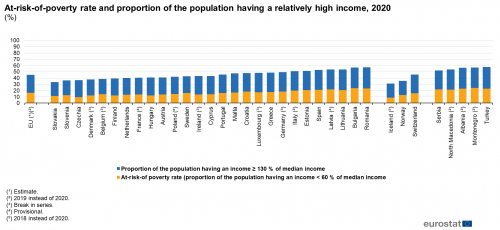
(%)
Source: Eurostat (ilc_li03) and (ilc_di20)
At risk of poverty rates were systematically much higher for single-parent households than for the overall population
An analysis of the risk of poverty by household type (see Table 1) provides an example of information that may be used to identify the most vulnerable groups in society, in order to target them with appropriate supportive policies. For example, at risk of poverty rates are systematically much higher for single-parent households than they are for the overall population: in 2020, the risk of poverty among people living in single-parent households in the EU was 31.3 %, compared with an average of 16.4 % for the total population. This pattern was repeated in each of the EU Member States and the risk of poverty remained high for people living in single-parent households even in Member States where the overall risk of poverty was low. For example, Czechia recorded the lowest share of at risk of poverty population. At the same time, the risk of poverty for single-parent households in this country was (at 31.9 %) more than three times as high as the risk experienced by the whole population (9.5 %), the biggest relative difference among the Member States.
A similar pattern, although at less pronounced scale, was often repeated for people living in households composed of two adults with three or more dependent children. Across the whole of the EU, their risk of poverty was 23.2 % in 2020, compared with an average of 16.4 % for the total population. There were, however, some EU Member States where the risk of poverty among people living in households composed of two adults with three or more dependent children was lower than average for the total population: Estonia, Latvia, Denmark, Slovenia, Hungary and Poland. By contrast, the risk of poverty for people living in households composed of two adults with three or more dependent children reached more than 50 % in Romania and Bulgaria, which was more than twice as high as the national average.
Severe material and social deprivation
While the risk of poverty is based on a relative monetary poverty definition, material deprivation provides a complementary view, based on objective and absolute criteria. Material deprivation refers to a state of economic strain, defined as the enforced inability to afford a set of indicative material standards, considered by most people to be desirable or even necessary to lead an adequate life. These include the inability to afford: unexpected financial expenses; a one-week annual holiday away from home; mortgage or rent payments, utility bills, hire purchase instalments or other loan payments; a meal involving meat, fish or a protein equivalent every second day; a car for personal use; heating to keep the home adequately warm and replacing worn-out furniture(at household level); and having an internet connection; replacing worn-out clothes by some new ones; having two pairs of properly fitting shoes (including a pair of all-weather shoes); spending a small amount of money each week on him/herself; having regular leisure activities; getting together with friends/family for a drink/meal at least once a month. The severe material and social deprivation rate is defined as the share of the population that is unable to afford at least four of the above-mentioned items.
In 2020, the severe material and social deprivation rate in the EU was 6.8 %; this marked an increase of 0.2 percentage points compared with the situation in 2019. In a majority (22) of the EU Member States, the severe material deprivation rate was less than one tenth and in eight countries even below 3 % (Poland, Slovenia, Estonia, the Netherlands, Sweden, Czechia, Finland and Luxembourg). At the other end of the range, the severe material deprivation rate reached more than 20 % in Bulgaria and Romania (Figure 5).
In a majority of the EU Member States, there were rather small changes in the proportion of the population that faced severe material deprivation between 2020 and 2019. However, there was a marked reduction in these rates in Lithuania (-1.6 p.p.) and Slovakia (- 1.4 p.p.). By contrast, the severe material deprivation rate increased in Germany between 2020 and 2019 from 3.0% to 4.7% which corresponds to 60%. This was the highest increase in relative terms. Moreover, in absolute figures the highest increase was also recorded in Germany (1.7 p.p.). Small increases (between 0.1 and 0.8 pp) were also noted in another eight EU Member States.
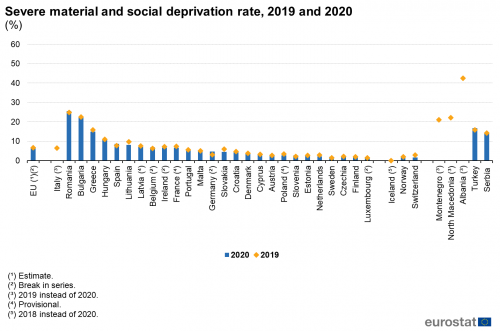
(%)
Source: Eurostat (ilc_mddd11)
Difficulties with making ends meet - a subjective indicator of poverty
Poverty and social exclusion can also be measured in a subjective way. One indicator that may be used to analyse these issues is the difficulty that people experience in making ends meet; this provides a self-reported measure related to poverty. Almost a fifth (18.5 %) of the EU population lived in households that perceived that they had either difficulty or great difficulty to make ends meet in 2020 (see Figure 6). There were wide variations of this indicator between EU Member States. More than half the population in Greece reported difficulty or great difficulty in making ends meet. By contrast, there were 16 Member States where less than one fifth of the total population was living in a household that faced difficulty or great difficulty in making ends meet; this share was lower than 10 % in Austria, Estonia, Denmark, the Netherlands, Sweden, Finland and Germany.
By contrast, just over one fifth of the EU population was living in a household where it was easy or very easy to make ends meet in 2020. In the Netherlands and Sweden more than half of the population was living in a household that perceived it as easy or very easy to make ends meet. Figure 6 represents a good visualisation of the distribution of the perception of the difficulties of making ends meet across EU Member States: from a very high proportion of the population reporting difficulties and small proportion of the population in the ‘middle category’ (fairly easily or with some difficulties) in Greece and Bulgaria, to the very low share of people with difficulties and a high share of those declaring a good economic situation of their households (in particular in Germany, Sweden, Finland, Denmark and the Netherlands).
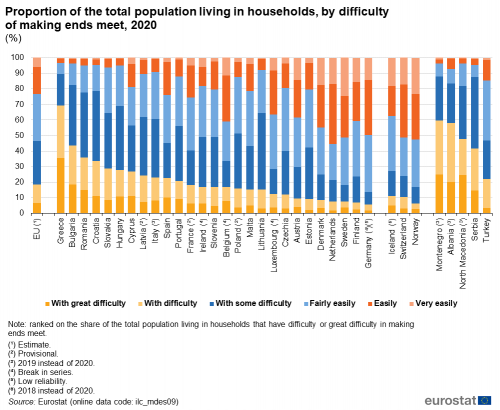
(%)
Source: Eurostat (ilc_mdes09)
Satisfaction with financial situation
In this section we take s look at a more subjective indicator, the satisfaction with the financial situation. A comparison between 2013 and 2018 reveals that overall the satisfaction with the financial situation has risen in all Member States except one, namely Lithuania, in which it went down by 0.6 on a scale from 0 to 10. The biggest increase took place in Ireland, where the rating went up by 1.7 (from 5.5 to 7.2), the only country to experience a change larger than 1 unit.
In 2018 the highest levels of satisfaction were measured in Denmark, Finland and Sweden (all at 7.6) followed by the Netherlands (7.4) and Austria (7.3). On the other side of the scale, there were eight countries where the satisfaction level was lower than 6 with the lowest rating being recorded in Bulgaria at 4.3.
Breaking down this indicator by educational attainment level reveals some interesting insights (Fig. 8). In all Member States the satisfaction level was significantly higher among the higher educated people when compared to the persons with a basic level of education (at most lowest secondary). The largest differences, of up to 2 points or more, were recorded in six countries: Czechia, Lithuania, Romania, Slovakia, Croatia and Bulgaria (which had the largest spread between educational levels, namely 2.6 points).
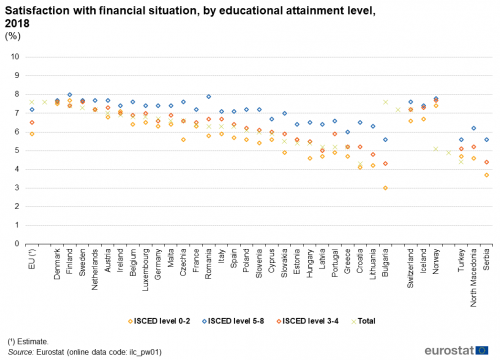
(%)
Source: Eurostat (ilc_pw01)
Housing conditions
Housing conditions have obviously an important impact on the quality of life. Low quality housing may be associated with reduced well-being and increased levels of psychological stress [1] and it is therefore of interest to analyze these aspects as a complement to information on material deprivation. There are several aspects of an objective nature that may form the basis for an evaluation of housing conditions in the EU, for example, structural problems within dwellings (such as damp walls or a leaking roof), overcrowding, or the lack of basic amenities (such as a toilet, shower or bath). For the purpose of this article, information is presented for the overcrowding rate and the share of the population living in dwellings with a leaking roof, damp walls, floors or foundation, or rot in window frames or floor.
Overcrowding rate and underoccupied dwellings
As already mentioned, when analyzing quality of life statistics, it is beneficial to also consider information in relation to the distribution of living conditions within each country, for example how large a share of the population is living in a situation close to average, or how many people live at the extremes at each end of the range in very poor or very good conditions. Therefore, Figure 9 contrasts the share of the population living in overcrowded housing with the share of the population living in under-occupied dwellings. In 2020, approximately one sixth (17.8 %) of the EU population was living in an overcrowded household, while almost one third (32.5 %) of the population was living in under-occupied dwellings. Some of these differences between EU Member States reflect societal habits and changes, in particular related to the importance of family ties and the increasing percentage of people living alone. In this respect, the situation varies from country to country; in rural areas of south and eastern Europe more extended families continue to live together under the same roof. See for example the publication People in the EU, who are we and how do we live?, page 48.
In 11 of the EU Member States, less than one tenth of the population was living in an overcrowded household in 2020, with shares of less than 4.0 % recorded in Cyprus. At the other end of the range, overcrowding impacted over 40.0 % of the population in Romania and Latvia.
On the other hand, in 2020, more than two thirds of the population in Cyprus and Malta were living in under-occupied house and this share was also more than half in the Netherlands, Spain, Belgium and Ireland. At the other end of the range, the proportion of the population living in under-occupied housing was less than 10.0 % in Romania.
As may be expected, EU Member States that recorded a high share of their population living in overcrowded dwellings tended also to record the lowest proportions of their population living in under-occupied housing. The reverse was also true; this pattern held across each of the Member States. The development of an increasing share of the population living in under-occupied housing may be linked, at least in part, to increasing longevity and a growing share of the elderly choosing to remain in their own house long after their children have left home but may also reflect local or national imbalances in the housing stock and consequently a lack of specific types of housing that prevent some people from moving.

(%)
Source: Eurostat (ilc_lvho05a) and (ilc_lvho50a)
From 2019 to 2020 the overcrowding rate increased slightly in the EU from 17.1% to 17.8%. In four Member States the rate did not change at all and in another eight countries the change was 0.5 percentage points or less. The biggest increases were recorded in Germany (+ 2.5 p.p.) and France (+2.1 p.p.). However, there were also EU countries where the rate dropped significantly. In particular, this was the case in Croatia (minus 2.3 p.p.) and Slovakia (minus 4.0 p.p.). Fourteen Member States saw a drop in overcrowding rate, whereas nine countries experienced an increase. (Fig.10)
Proportion of the dwellings having structural problems
In 2020, some 13.9 % of the EU population was living in low-quality housing (defined here as a dwelling with a leaking roof, damp walls, floors or foundation, or rot in its window frames or floor). The existence of such problems was particularly acute for vulnerable groups within society. For example, almost a fifth (19.9 %) of the population in single-parent households lived in a dwelling with these problems, whereas the share for the population living in households composed of two adults where at least one of which was aged 65 years or over, was about half that recorded for single-parent households, at 11.0 % (see Figure 11).
Among the EU Member States, the proportion of the population living in a dwelling with a leaking roof, damp walls, floors or foundation, or rot in the window frames or floor in 2020 peaked at 39.1 % in Cyprus, while shares above 20 % were also recorded in Portugal, Slovenia and Hungary. On the other hand, there were eight Member States where fewer than 1 in 10 persons experienced living in low-quality housing, namely Croatia, Austria, Sweden, Czechia, Malta, Poland, Slovakia and Finland (where the lowest share was recorded at 4.5 %).
In most EU Member States, the proportion of the population living in single-parent households that faced low-quality housing in 2020 was higher than the average for the total population, although there were exceptions in Slovakia, Estonia, Latvia and Czechia. A relatively high share of the population living in single-parent households faced living in such conditions in Ireland, the Netherlands and Denmark, as each reported a share for this subpopulation that was at least 10.0 percentage points higher than the average for the total population.
By comparison, for most EU Member States a lower than average share of the population in households composed of two adults where at least one of them was aged 65 years or over faced living in low-quality housing; this was particularly true in Denmark. By contrast, there were six Member States where a higher proportion of the population living in such households faced living in low-quality housing (compared with the total population); this was particularly the case in Malta, Croatia and Cyprus.
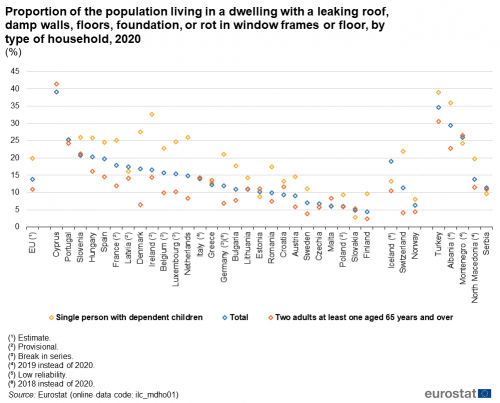
(%)
Source: Eurostat (ilc_mdho01)
Source data for tables, figures and maps(MS Excel)
Data sources
Material living conditions refer to an individual’s standard of living as expressed through three different sub-dimensions: income, consumption and material living conditions. The data used in this section are derived from EU statistics on income and living conditions (EU-SILC). EU-SILC are compiled annually and are the principal European source for measuring income and living conditions, as well as the leading source of information for analysing different aspects related to the quality of life of households and individuals.
Methodology
Quality of life, even for those dimensions that extend beyond material costs, are often constrained and shaped in a fundamental way by economic (monetary) conditions. Material resources are however only a means for transforming an individual’s well-being according to their own preferences, values, free will and capabilities. Indeed, while material resources do not guarantee happiness, they are clearly beneficial to most individuals who strive to improve their quality of life. In this sense, material living conditions, while not intrinsically reflecting an individual’s quality of life, nevertheless provide a framework to measure the potential of individuals/households to achieve and ensure their own self-defined well-being.
GDP is a measure of economic activity (either from an expenditure, income or output perspective). When divided by the number of inhabitants, GDP per capita has traditionally been used as an indicator to measure economic well-being, or more precisely standards of living for a (sub) population. While an economy’s performance from the macroeconomic perspective is certainly crucial to the overall level of a society’s material well-being, material living standards are more closely associated with real household income and household consumption. Indeed, there is increasing awareness among statisticians that the development of average income and consumption at a national level (as measured within the framework of national accounts) may diverge considerably from the income of a typical household, as its distribution is unevenly shared. By contrast, household-oriented statistical surveys, like EU-SILC facilitate the estimation of median (rather than mean) values, which are less prone to distortions. Furthermore, surveys such as EU-SILC also provide more complete information on distributions within subpopulations, for example, allowing an analysis by income quintile, by sex, by age and by level of educational attainment, thereby providing a more detailed picture of the actual distribution of material living conditions.
For cross-country comparisons, income expressed in national currency terms is generally misleading (even in the case of a common currency, such as the euro, or after converting different currencies using exchange rates) given there are differences in price levels between economies: for example, a loaf of bread does not cost the same price in Budapest as it does in Copenhagen. To ensure comparability purchasing power parities (PPPs) are calculated and factored in. Accordingly, income estimations in euro terms or national currencies are converted into a common unit, called a purchasing power standard (PPS) — these represent a virtual currency, a unit of which has the same purchasing power regardless of the different price level in each country. Monetary poverty indicators are designed to reveal the share of a (sub) population that is facing difficulties to achieve a minimum standard of living; such indicators are relative in nature and will vary from one country to another reflecting the different price levels in each economy.
In order to define the share of the population who are considered to be living below the minimum standard of living, a threshold is generally used, traditionally this has been set to 60 % of the national median equivalised disposable income (after social transfers). Note that this measure does not provide any information on absolute wealth or poverty, but instead identifies people whose income is low in comparison with other residents in the same country; it is important to bear in mind that this does not necessarily imply a low standard of living.
The concept of equivalized disposable income is used to reflect the fact that incomes of individuals are often shared within a household and usually this will help to achieve economies of scale. The equivalized disposable income is the sum of all income from all different sources acquired by all members of a household, divided by an equivalized household size, according to a standard scale, to take into account the composition of the household in terms of the number of adults and children. The median equivalised disposable income of a country (or a region or a demographic or socioeconomic stratum) may therefore be used as a proxy for the standard of living. Since income distributions are often characterized by extreme outliers, in particular in the high income groups, the use of the median — rather than mean — ensures a more representative estimation.
While monetary indicators may be used to analyze the distribution of income across different socioeconomic groups, they should ideally be complemented by indicators on material conditions — such as material deprivation and housing conditions — designed to measure poverty in absolute (rather than relative) terms. In other words, these indicators are based on using the same set of standards for each country or (sub) population, for example, can the population afford to go on holidays, can they keep their homes adequately warm, or are they confronted with arrears when paying their rent, mortgage or utility bills?
Context
People use material resources, according to their own values and priorities, to pursue their own interests and self-defined well-being. An individual’s quality of life is, therefore, fundamentally constrained by their access to material resources, some of which are transformed into well-being. In this perspective, material living conditions, while not intrinsically reflecting the quality of life, may provide a proxy for measuring it.
The importance of having access to material resources is recognized at a political level within the EU. Reducing poverty, by lifting at least 15 million people out of the risk of poverty or social exclusion, is one of the three EU targets within the Action Plan for the implementation of the European Pillar of Social Rights, which provides the EU’s strategy for a fairer Europe through to 2030 for an economy that works for people.
Direct access to
- All articles on living conditions and social protection
- Quality of life indicators (online publication)
- Income distribution and monetary poverty (t_ilc_ip)
- Monetary poverty (t_ilc_li)
- Monetary poverty for elderly people (t_ilc_pn)
- In-work poverty (t_ilc_iw)
- Distribution of income (t_ilc_di)
- Income distribution and monetary poverty (t_ilc_ip)
- Material deprivation (ilc_md)
- Material deprivation by dimension (t_ilc_mddd)
- Housing deprivation (t_ilc_mdho)
- Environment of the dwelling (t_ilc_mddw)
- Material deprivation (ilc_md)
- Quality of life, see:
- Material living conditions (qol_mlc)
- Productive or other main activity (qol_act)
- Health (qol_hlt)
- Education (qol_edu)
- Leisure and social interactions (qol_lei)
- Economic security and physical safety (qol_saf)
- Governance and basic rights (qol_gov)
- Natural and living environment (qol_env)
- Overall experience of life (qol_lif)
- Income distribution and monetary poverty (ilc_ip)
- Monetary poverty (ilc_li)
- Monetary poverty for elderly people (ilc_pn)
- In-work poverty (ilc_iw)
- Distribution of income (ilc_di)
- Material deprivation (ilc_md)
- Material deprivation by dimension (ilc_mddd)
- Economic strain (ilc_mdes)
- Economic strain linked to dwelling (ilc_mded)
- Durables (ilc_mddu)
- Housing deprivation (ilc_mdho)
- Environment of the dwelling (ilc_mddw)
- Income distribution and monetary poverty (ilc_ip)
Notes
- ↑ Abdallah, S. and Stoll, L. (2012), Review of individual-level drivers of subjective well-being, produced as part of the contract ‘Analysis, implementation and dissemination of well-being indicators’, Eurostat.

